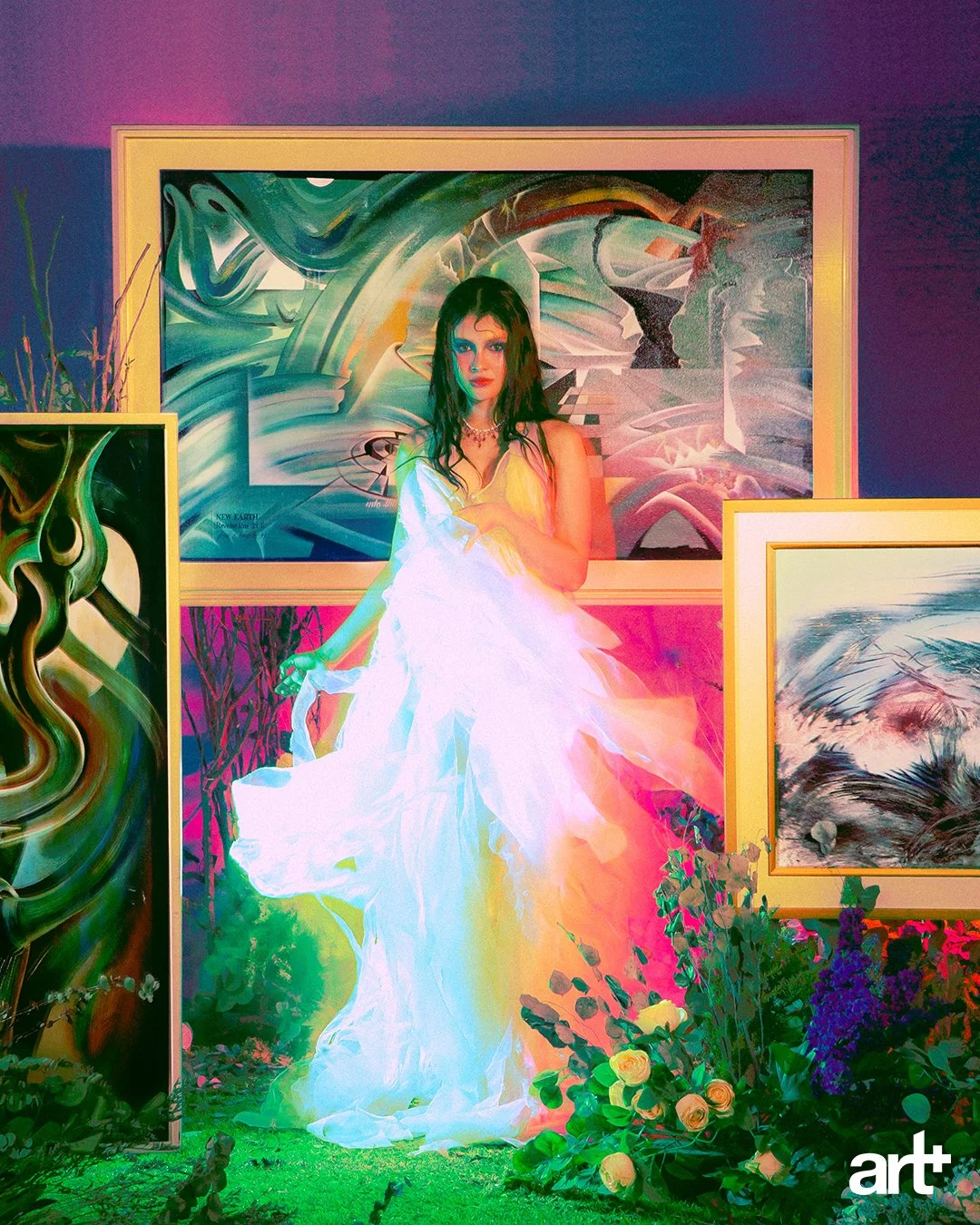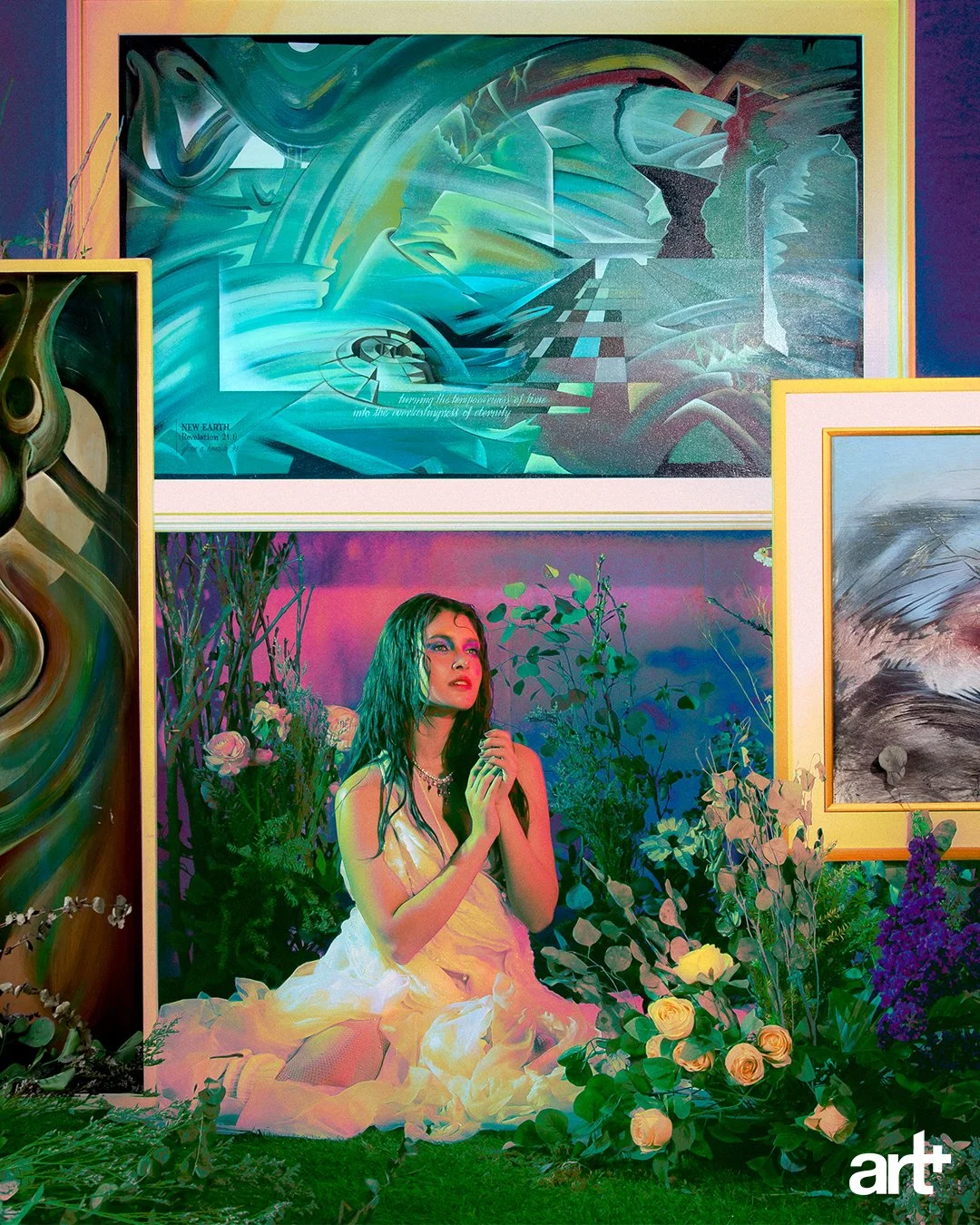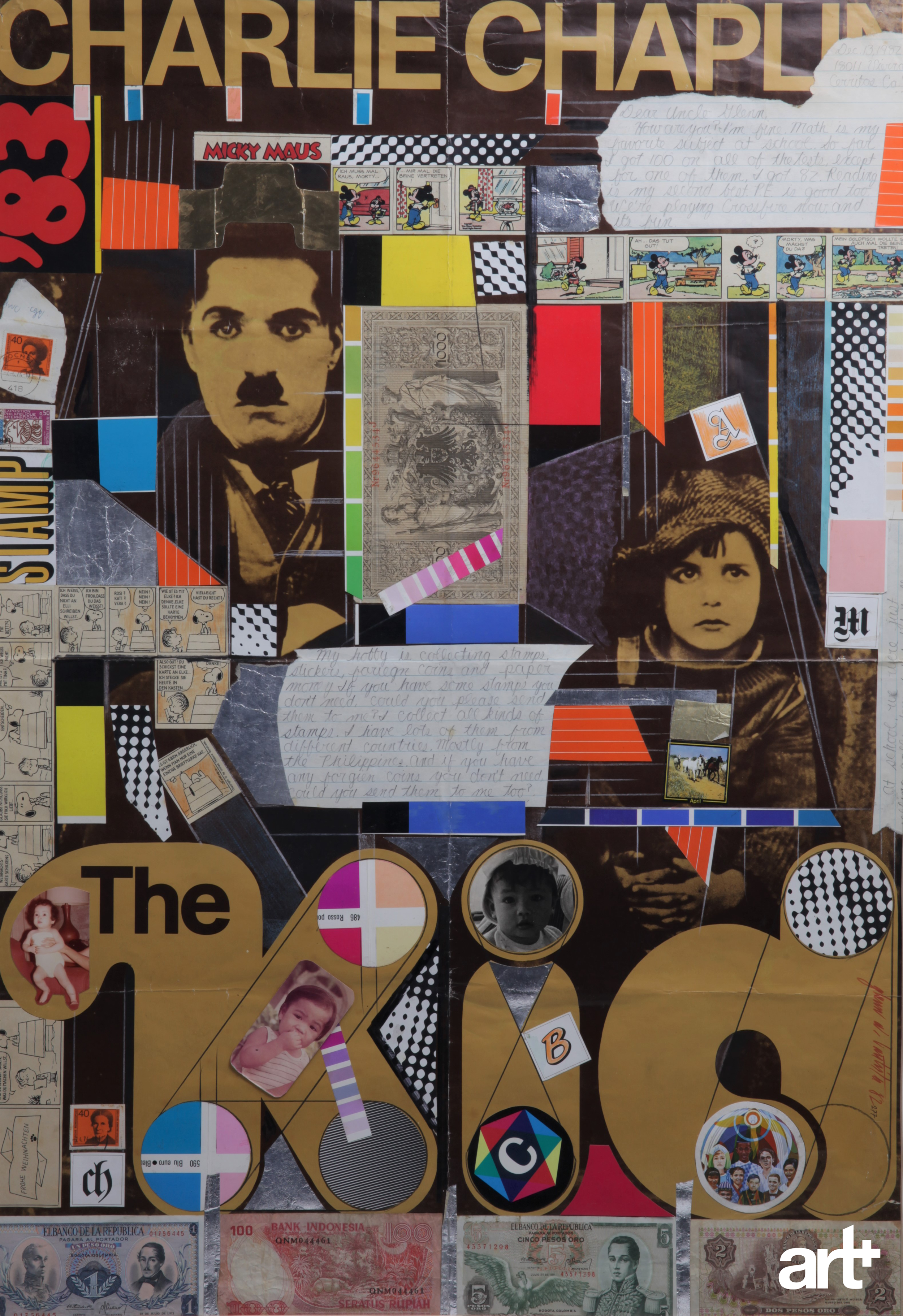Glenn Bautista: An Exception to the Rule
Constant experimentation, restless exploration, and unending reinvention describe the late maverick artist—whose life and work are retold in a book that preserves his legacy.
Words Pocholo Concepcion
Photography Jovel Lorenzo
April 5, 2024
The Art+ office was abuzz with excitement. Rabiya Mateo, 2020 Miss Universe Philippines and current Sparkle GMA Artist Center talent, was acting as the medium for the art of Glenn Bautista on the cover of the magazine’s March-April issue 90.
It’s Mateo’s first time to grace the cover of a glossy, and she was visibly thrilled to collaborate with Art+ creative director Kim Albalate’s concept.
“Glenn Bautista was not the typical artist boxed into one medium. His works ranged from oils to collages to materials such as wood and stones, and to choose which to highlight on the cover was quite a challenge. And yet there’s something about his abstract works that was ahead of its time and which today’s generation would appreciate,” said Albalate.
“And since this issue is also about women empowerment, we wanted someone confident enough to be the extension of the canvas and bring Bautista’s art to life. Rabiya Mateo is the perfect ‘medium’ for the concept. She was open to the ideas we discussed.”
Rabiya Mateo wears Deathless dress from Jeremy Bautista of h._.waa, Jewelry from LVNA By Drake Dustin
Bautista was, indeed, ahead of his time.
The visual artist was deemed “too progressive, too experimental, too restless,” even as he came of age in the 1960s and ’70s—periods in modern history which were defined by rebelliousness and unconventionality.
An upcoming book, Glenn Bautista:
An Artist Drowning in Visions (published by Gallery Genesis), brings to life the remarkable story of “a unique and singular figure in Philippine art.”
The book’s author, Igan D’Bayan, gives an intriguing portrait of the man he calls an “exceptional artist.”
“There was a time when I could only view, interpret things I see around where light would come from within. This approach to painting started when I was at a beach in Matood, Batangas. Embers still lit at night was quite a sight for me to behold.”
Art+: You were commissioned to write a book on Glenn Bautista and his work as a visual artist. Tell us how you approached the project.
The upcoming book, Glenn Bautista: An Artist Drowning in Visions, is written by Igan D'Bayan and published by Gallery Genesis.
Igan D’Bayan: This project was different from the other book that I worked on during the pandemic (Double Vision, which is about the BenCab and Ronald Ventura collaboration at Secret Fresh). Glenn Bautista passed away in 2014, and we could not get hold of his son David, so the only person I could interview who was closest to the artist was his art patron, Ernie Salas. Mr. Salas is a repository of stories about Bautista’s exploits as an artist. He told me that the local art scene of the time was not prepared for Bautista’s art: too progressive, too experimental, too restless. Bautista had so many artistic phases that if you gathered some of his paintings in a gallery, you would think that the paintings were done by different artists.
Thankfully, Bautista kept a blog and did several interviews with foreign journalists, thus I was able to gain insights on what ran through the man’s mind— everything from his upbringing as the son of a Methodist minister, to rubbing elbows with artists such as Joseph Beuys in Düsseldorf, to his few remaining years in Houston, Texas, still making art.
Title: Dasmarinas I
Medium: Oil
Size: 24 x 24 inches
Year: 1995
Provenance: Direct from the artist
Photo Credit: David Fabros
Title: Nature and Technology II Medium: Pastel
Size: 12.5 x 12.6 inches
Year: 1983
Photo Credit: David Fabros
Title: Providence
Medium: Oil
Size: 32 x 48 inches
Year: 1994
Photo Credit: David Fabros
Title: New Creation
Medium: Oil
Size: 37 x 59.5 inches
Year: 1993
Photo Credit: David Fabros
Title: The Rural Conceptions of God Medium: Oil
Size: 37 x 57 inches
Year: 1993
Provenance: Direct from the artist
Photo Credit: David Fabros
Title: Inner Circle
Medium: Watercolor
Size: 10.5 x 14.75 inches
Year: 1998
Provenance: Direct from the artist
Photo Credit: David Fabros
Bautista was 17 years old in 1965 when he joined the International Christmas Art Competition in New York and won first prize among 64 entries. Would you consider his incorporating geometric shapes into scenes from The Nativity and other religious symbols in his winning work, “The Event,” advanced for his age?
Not particularly. Glenn was probably aware of the artistic experimentations happening in the United States and Europe at that time. What was more impressive were his pen-and-ink renderings in the late 1960s while he was still at the UP College of Fine Arts. He drew the Rizal statue by Guillermo Tolentino using horizontal lines of varying widths. Quite a feat.
From his earliest works that channeled religion and history, Bautista, taught by one of his professors at Brooks Institute to “go inwards” to search for one’s “inner self,” ventured into abstract art starting with his “Woodscape” series in 1970. What do you think of this development?
That period in his life was very productive. He was painting tree rings and equating them with the light inside each of us, but he was also into abstracts, and portraits (of Virginia Davis Laskey), murals (“America”). In the early ’70s, he would travel across Europe and get inspired even more.
Media coverage in the US in 1972 described Bautista’s work as having elements of science fiction and surreal imagination. Do you think he was a maverick?
Absolutely. If he stuck to a single, identifiable style – just like what his contemporaries were doing at that time – he would have been more successful commercially. But, as he wrote on his blog, painting with the sole intention of being able to sell paintings is, for him, a “violation” of himself. The muse was his number one priority, not the gods of career or legacy. Today’s artists could learn a lot from this line of thinking.
Portrait of Glenn Bautista
Bautista’s return to the Philippines after two years in art school in the US was marked by well-received shows in Manila and being a re- cipient of the CCP’s Thirteen Artists Award. How would you describe his work during the Martial Law years?
Bautista was named as one of the Thirteen Artists, along with equally deserving ones such as Tony Perez and Nestor Vinluan. Regarding Glenn’s art during Martial Law, I did not see anything overtly political, or which had a social realism bent. That was based on Mr. Salas’ collection of Bautista’s work at that time. Maybe an artwork in the home of another collector will disprove that. Who knows?
“I don’t paint to sell or paint because it sells. How can I do that? I’d be violating myself.”
In 1980, he left the country again and lived for five years in Dusseldorf, Germany to study lithography. Do you think this reflected his need to learn something new?
Yes, the man was always restless. That was the time he became great friends with Joseph Beuys. Mr. Salas recalled how Glenn told the gallery owner that he should mount an exhibition of Beuys’ work in Manila. Imagine if that show became a reality. That would rock, indeed.
In Germany, Bautista was at his most creative and artistically curious self, for instance, with cutouts and collages, combining whatever materials he could get his hands on: Charlie Chaplin movie posters, Adolf Hitler and Martin Luther photographs, Donald Duck comic strips, postage stamps, packets of Marlboro or Nescafé, and leaves, among other things. He was like a conductor, collaging these different elements and creating something else entirely.
Title: Charlie Chaplin III
Medium: Collage
Size: 23 x 33 inches
Year: 1982
Provenance: Direct from the artist
Photo Credit: David Fabros
Title: Charlie Chaplin I
Medium: Collage
Size: 23 x 33 inches
Year: 1982
Provenance: Direct from the artist
Photo Credit: David Fabros
Title: Charlie Chaplin II
Medium: Collage
Size: 23 x 33 inches
Year: 1982
Provenance: Direct from the artist
Photo Credit: David Fabros
How would you describe and make sense of Bautista’s transitions in style and methods in making art?
If you will read his blog entries, you’ll discover that there was always an internal debate within Glenn Bautista. Questions on life, religion, and art were rattling inside his head. And the way he was able to make a better sense of what was happening to him internally was to make art.
Which among his works have impressed you the most, and why?
He had this series of collages that, to me, evoke images of ribcages and the skeletal system, reminiscent of the work of the Polish painter Zdzisław Beksiński. I found it challenging to categorize, so I opted for labelling them under “Uncommon Art.” Bautista’s body of work contains numerous pieces that defy easy categorization. And that is, for me, the mark of an exceptional artist.
Title: Wooden Leaf E
Medium: Mixed Media
Size: 4 x 3 inches
Year: 1985
Provenance: Direct from the artist
Photo Credit: David Fabros
Title: Wooden Leaf F
Medium: Mixed Media
Size: 4 x 3 inches
Year: 1985
Provenance: Direct from the artist
Photo Credit: David Fabros
Title: Wooden Leaf I
Medium: Mixed Media
Size: 4 x 3 inches
Year: 1985
Provenance: Direct from the artist
Photo Credit: David Fabros
It is intriguing when viewers are unable to pinpoint the intended meaning of a piece of art but still find themselves drawn to it. Just like what my mentor, the poet Ophelia Dimalanta, always said: A great poem is felt first, before it is fully understood. While I can’t recall the exact quote (I’ve managed to explain it in threadbare syntax), the essence remains something along those lines.
As an artist yourself, what have you gained or learned from looking at Bautista’s body of work?
There are a lot of things that I don’t get, in terms of Bautista’s art, many things I don’t even particularly like, but I am impressed by his absence of fear in making something innovative and new.
Do you think his works are worth rediscovering today?
When you read books about Filipino artists, you get the impression that art history is linear, a straightforward progression from one point to another. However, reality is filled with unexpected twists and lesser-known narratives. There are valuable insights in making detours and exploring backroads. So many stories and influential artistic figures that may have escaped our awareness but are fundamental to the evolution of Philippine art. Glenn Bautista stands as a noteworthy example among them.
Title: Romblon Gray Stone Test I Medium: Lithograph
Size: 4 x 8 inches
Year: 1985
Provenance: Direct from the artist
Photo Credit: David Fabros
Title: Romblon Gray Stone Test II Medium: Lithograph
Size: 4 x 8 inches
Year: 1985
Provenance: Direct from the artist
Photo Credit: David Fabros
Title: Untitled
Medium: Lithograph
Size: 5.75 x 8.25 inches
Year: 1980
Provenance: Direct from the artist
Photo Credit: David Fabros
What is Glenn Bautista’s legacy in Philippine art?
Glenn Bautista’s approach to artmaking is an invaluable one. It is about constant experimentation, restless exploration, and unending reinvention. How many of today’s contemporary artists can say they, too, transcend convenient categorization? Looking at Bautista’s body of work now, you’d get the erroneous impression that they are the creations of multiple artists. In this aspect, Glenn Bautista stands as a unique and singular figure in Philippine art.
The book Glenn Bautista: An Artist Drowning in Visions is published by Gallery Genesis, 2/F North Wing, Estancia Mall, Pasig; contact 0945 612 9995
Words Pocholo Concepcio, Photography JOVEL LORENZO, Creative Direction SANTI ALBALATE, Stylist MIKA REYES, Styling Assistants NIKKA BAÑAGA & VIANCA OZABEL, Make-up Artist ASH BANTILAN, Hairstylist KENDRA ELMIRA MENDEZ, Video Producers AMBROSIA RENEE CONCEPCION & MARICAR LEYESA
Rabiya Mateo wears deathless dress from Jeremy Bautista of h._.waa
Jewelry LVNA By Drake Dustin
Special thanks to CHESTER JAN SINGIAN, JASHLEY CRUZ, and SPARKLE GMA ARTIST CENTER




















